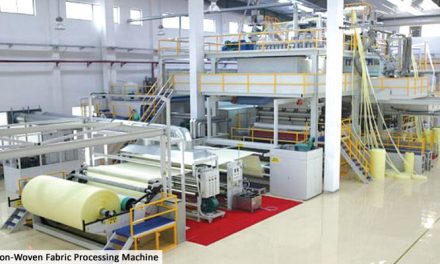This article explores the relationship between the industrial revolution and Industry 4.0, highlighting how technology has driven both to improve people’s lives. Smart manufacturing is a production method that uses interconnected networks to allow for data exchange and real-time adjustments to the production process. This paper outlines the various technologies involved in smart manufacturing, including cyber-physical systems, the Internet of Things, artificial intelligence, machine learning, and big data analytics.
 This article explores the relationship between the industrial revolution and Industry 4.0, highlighting how technology has driven both to improve people’s lives. Smart manufacturing is a production method that uses interconnected networks to allow for data exchange and real-time adjustments to the production process. This paper outlines the various technologies involved in smart manufacturing, including cyber-physical systems, the Internet of Things, artificial intelligence, machine learning, and big data analytics.
This article explores the relationship between the industrial revolution and Industry 4.0, highlighting how technology has driven both to improve people’s lives. Smart manufacturing is a production method that uses interconnected networks to allow for data exchange and real-time adjustments to the production process. This paper outlines the various technologies involved in smart manufacturing, including cyber-physical systems, the Internet of Things, artificial intelligence, machine learning, and big data analytics.
Despite these challenges, the Indian government has implemented policies and initiatives to promote the adoption of advanced technologies in the textile industry, such as IoT, big data, and AI, to improve automation and reduce human intervention, ultimately improving the industry’s overall efficiency and competitiveness.
Keywords: Artificial intelligence, Big data analytics, Human-machine interaction, Data integration, Data management, Indian textile industry, Smart factories, Smart manufacturing.
Introduction
The article delves into the correlation between the industrial revolution and Industry 4.0, emphasizing that technology has propelled both to enhance people’s livelihoods. The incorporation of machinery, steam power, agriculture, and transportation distinguished the initial industrial revolution of the 18th and 19th centuries. The Fourth industrial revolution (Industry 4.0) is typified by the amalgamation of digital technology and the internet, resulting in new capabilities such as manipulating the physical realm in previously unfeasible ways.
The paper discusses the relationship between the industrial revolution and Industry 4.0, noting that both have been driven by the use of technology to improve people’s lives. Industry 4.0, or the fourth industrial revolution, is characterized by integrating digital technology and the internet into various industries, leading to new capabilities such as manipulating the physical world in previously impossible ways. Smart manufacturing is a method of production that uses interconnected networks to allow for data exchange and real-time adjustments to the production process. It utilizes advanced technologies such as cyber-physical systems, big data analytics, IoT, cloud computing, robotics and automation, and deep learning.
The objective of smart manufacturing is to optimize energy, productivity, and costs across factories and companies by gathering and evaluating data at all levels of the supply network and making decisions based on that data in real time. It endeavors to operate in a predictive and preventive manner by monitoring and controlling the production process.
A Smart factory is a manufacturing facility that employs a blend of automation, connectivity, and data analytics to establish a highly flexible and adaptable production environment. A smart factory aims to augment efficiency and flexibility by connecting multiple processes, data streams, and stakeholders in an integrated manner. Also referred to as a digital or intelligent factory, it presents an opportunity to enhance manufacturing capabilities by utilizing technology to optimize and streamline operations. The paper also highlights the strategic value of smart factories as they have been demonstrated to be successful and innovative by early adopters, and manufacturers believe that smart industries will become significant competitive industries by 2025, changing the way products are made. Various technologies involved with smart manufacturing are as follows:
• Cyber-physical systems (CPS) is a concept that brings together control, computerization, and communication to integrate the physical and digital worlds seamlessly. It strives to achieve real-time network-based control and is becoming increasingly prevalent in advanced production.
• The Internet of Things (IoT) is a crucial aspect of smart manufacturing as it enables the data collection from various production areas, such as equipment, products, workers, and trucks, and connects them to online computer platforms. Integrating IoT with CPS allows for the collection and transmission of data in various forms, resulting in better utilization of decision-making and algorithms.
• Artificial Intelligence (AI) is also a critical component of smart manufacturing, enabling accurate and reliable decision-making by analyzing and processing large amounts of data. Machine learning (ML) is a branch of Artificial Intelligence (AI) that employs historical data to train computers to predict outcomes, solve complex problems, and enhance production efficiency.
• Big Data plays a significant role in smart manufacturing by integrating prescheduled systems to provide companies with a clear picture of their production processes and automating data collection and analysis. Big data can be used for data analysis in production to enhance efficiency by identifying and studying events unrelated to production plans.
Methodology: The paper describes how smart manufacturing and integrating advanced technologies such as cyber-physical systems, IoT, AI, ML, and big data analytics can optimize energy, productivity, and costs across factories and companies. It highlights the use of 3D scanning for quality control processes and the benefits of using digital twins, AR, and VR to improve the production process. The paper also describes a case study of a new factory operating company that has implemented these technologies resulting in significant cost savings and faster completion of personal orders. The company also aims to expand its capabilities to cover the entire end-to-end supply chain. Overall, the paper emphasizes the strategic value of smart factories and their potential to change the way products are made soon.
Case Studies: M/s Silver Spark Apparels, a subsidiary of Raymond Ltd, implemented a smart production system in one of their industries. They have upgraded their Made-to-Measure (MTM) production of blazers and jackets for export by improving fabric quality, cutting, texture design of cut-out parts, and design doors. They have also implemented a barcode system to track its large production system more harmoniously. The barcode system also tracks fabric inventory, raw material, order condition, and blazers’ compression. They have implemented production planning software and line measurement solutions as two software programs taken by Raymond on their journey. They also built their quality tracking control system with the help of RFID, integrated an SMS-based sewing machine repair program, an internal conservation system, a power monitoring system, and a fuel consumption monitoring system. They have used the Kanban digital and live production systems to track the ongoing production process, Barcode for every piece, and digital communication system in-house.
 Discussion: The paper enumerates the various advantages of incorporating smart industry techniques in manufacturing, which include:
Discussion: The paper enumerates the various advantages of incorporating smart industry techniques in manufacturing, which include:
i) Enhanced product quality: By leveraging big data analytics, manufacturers can gain insights into consumer preferences and identify areas for improvement in the quality of their products.
ii) Reduced costs: Smart factories can operate at lower inventory levels, reducing costs associated with identifying and providing networks. The cost of managing assets decreases significantly, resulting in less waste and downtime. Smart factories also have low power consumption and improved processes, leading to lower warranty and repair costs.
iii) Greater flexibility: Smart factory logistics systems can handle different operations, providing greater flexibility. Advanced sensor technology can automatically detect changes in production demand, allowing the company’s supply chain to respond quickly.
iv) Enhanced productivity: Real-time data allows manufacturers to respond quickly to production needs, resulting in less downtime and waste. This leads to faster delivery and increased customer satisfaction.
v) Energy efficiency: Smart factories can aid in reducing the carbon footprint by decreasing waste and increasing energy efficiency. This helps address climate change and reduces the cost of goods, and makes them more affordable for the end buyer.
vi) Smart monitoring and control: Smart factories use monitoring and control systems that send alerts when equipment, engines, or bearings need to be repaired. This allows maintenance teams to address issues before they cause major production disruptions. This improves the overall efficiency and reliability of the production process.
vii) Better decision-making: Smart factories use data analytics to provide realtime insights, which can help managers make better decisions and improve overall business performance. This can include identifying inefficiencies, identifying areas for cost-saving, and improving production planning.
viii) Enhanced safety: Smart factories use sensors and other technology to monitor the workplace environment and identify potential safety hazards. This can lead to improved safety conditions and a reduction in workplace accidents.
ix) Better tracking and traceability: Smart factories use advanced tracking systems, such as RFID, to monitor inventory and production processes, providing better visibility and control over the supply chain. This can also help with compliance with regulations and industry standards.
x) Predictive maintenance: This uses data from existing systems to send repair alerts and repair security reminders to prevent equipment breakdowns before they occur. This improves the overall performance and longevity of the equipment, resulting in less downtime and increased productivity.
xi) Increased competitiveness: Smart factories can give companies a competitive advantage by improving efficiency, reducing costs, and increasing flexibility. This can help them stay ahead and capture new market opportunities.
Implementing smart industry 4.0 in manufacturing can bring significant benefits to organizations, such as improved product quality, cost savings, increased flexibility, and enhanced productivity. However, several technical and organizational challenges must be considered before implementing a smart factory system. These challenges include employee resistance to change, data integration and management, cyber security, human-machine interaction, scalability and maintenance, and real-time data processing. Some of the obstacles to implementing smart factory initiatives:
Resistance to change – Many of the workforce may be averse to introducing novel technologies and techniques, owing to their comfort with the status quo. This can impede the acceptance and adoption of smart factory projects, making it challenging to execute and maintain their success.
Cyber security – As smart factories are highly connected and reliant on digital technologies, they are vulnerable to cyber-attacks. Ensuring the security of the factory’s network, systems, and data is crucial to protect against unauthorized access and data breaches.
Information security – The integration and dependence on technology in smart factories elevates the likelihood of cyber-attacks and data breaches. To counteract these potential hazards, robust information security protocols must be in place to safeguard sensitive data and systems and guarantee their confidentiality and integrity.
Data integration and management – Integrating and managing data from various sources, such as machines, sensors, and production processes, is a complex task requiring advanced technologies such as IoT, big data analytics, and cloud computing.
Human-Machine Interaction – Another challenge is the interaction between humans and machines in a smart factory. Ensuring that the factory’s systems and processes are user-friendly and easy to operate is crucial to optimize productivity and efficiency.
Organizations need to have a comprehensive plan in place to address these challenges and ensure the successful implementation and sustainability of smart factory initiatives.
Conclusion
Smart manufacturing has the potential to revolutionize the textile industry by improving efficiency, reducing costs, and increasing competitiveness. The Indian Government has recognized the potential of smart manufacturing. It has implemented several policies and initiatives to promote the adoption of advanced technologies in the textile industry, such as IoT, big data, and AI. These initiatives aim to improve automation and reduce human intervention, ultimately improving the textile industry’s overall efficiency and competitiveness. However, challenges still need to be addressed, such as data analysis and interpretation, and data security, to fully realize the benefits of smart manufacturing in the textile industry. With the right support and policies in place, the Indian textile industry has the potential to become a significant player in the global market.
(Contributed by Dr. Chavi Goyal & Dr. Shipra Sharma, Assistant Professor &
Associate Professor, Department of Fashion Technology, NIFT, Panchkula)

















